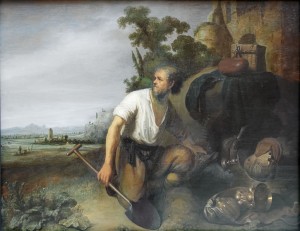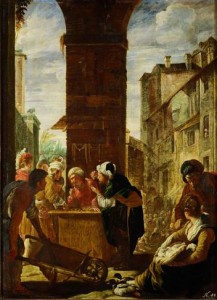 “‘The kingdom of heaven is like a treasure hidden in the field, which a man found and hid again; and from joy over it he goes and sells all that he has and buys that field. Again, the kingdom of heaven is like a merchant seeking fine pearls, and upon finding one pearl of great value, he went and sold all that he had and bought it.'” (Matthew 13:44-46)
“‘The kingdom of heaven is like a treasure hidden in the field, which a man found and hid again; and from joy over it he goes and sells all that he has and buys that field. Again, the kingdom of heaven is like a merchant seeking fine pearls, and upon finding one pearl of great value, he went and sold all that he had and bought it.'” (Matthew 13:44-46)
Probably my most favorite of all Christ’s parables are The Hidden Treasure and The Costly Pearl. According to dictionary.com, a parable is “a short allegorical story designed to illustrate or teach some truth, religious principle, or moral lesson.”
And so it is true with The Hidden Treasure and The Costly Pearl. Jesus uses both “stories” to explain something about the reality / dynamic / experience of the kingdom of God.
SIMILARITIES OF THE PARABLES
And before I explain the parables I’d like to highlight their similarities (which will help with interpretation, also).
And so, first of all, we have a treasure in the one and a pearl in the other. They are similar. Added to that, we have a man in the one and a merchant in the other. Those are a match. Next, each (the man and the merchant) are seeking, then finding something. That goes together. And then now, finally, they (the man and the merchant) upon finding the treasure and the pearl, go off and sell everything to buy each. (The difference is the treasure is hidden again after having been found and the man buys the field where the treasure is.) So, again, we have treasure and pearl, man and merchant, seeking and finding, selling all and buying.
EXPLANATION OF THE PARABLES
Now we come to the explanation of the parables.
To understand each it is most important to pinpoint the identity of the two main characters of the stories. Namely, who is the man and who is the merchant? Each are doing a number of things (as I’ve already pointed out).
There are those that would suggest that the man and the merchant are the believer who finds Christ. Thus, Jesus is the treasure and Jesus is the pearl. Or as others might point out, it’s the Gospel, salvation or the Church that is the treasure and / or pearl of which the sinner sells (surrenders) all to receive, obtain, become a part of.
The problem with that is a person in his sinful state has nothing to sell to purchase anything. (Romans 3:10, 23)
A better interpretation (and one that makes more sense and is consistent to the entirety of the Scriptures) is that the man and the merchant are Christ. Then everything flows. Of course, it is He who is the One doing the seeking and finding. (It’s funny how people who get saved say they “found Jesus.” He was never lost. They were.) (Luke 19:10)
THE HIDDEN TREASURE
And so as it has to do with the first parable, a man (representing Jesus) comes across a treasure in a field. The field is the world. Israel is the treasure. (Exodus 19:5; Psalm 135:4) She received Him not at the first and thus was “hidden” again. (John 1:11) Israel lost her place in the plan of God as it were, but not forever.
Now I like how the Wycliffe Commentary develops the rest of the parable: “Christ gave his very life (all that he hath) to purchase the whole field (the world, 2 Corinthians 5:19; 1 John 2:2), and thus obtained full ownership by right of discovery and redemption. When he comes again, the treasure (of Israel) will be unearthed and fully displayed (Zechariah 12:1-14 and 13:1-9).”
This, too (the restoration of Israel), is further confirmed in the New Testament Scriptures, especially in Romans 11:1-32.
As it has to do with the second parable, a merchant (representing Jesus) comes across a costly pearl. This is the Church. (Ephesians 1:4; 5:27)
The Wycliffe Commentary does well in developing this parable as well: “Christ … came seeking men and women (goodly pearls) who would respond to him and his message. Eventually, he gave his life (all that he had) to purchase one pearl of great price (1 Corinthians 6:20). The one pearl depicts that other great company in the Kingdom, the Church, composed of men and women who are made one in the Church (1 Corinthians 10:17; 12:12-13).”
One question remains: Have you responded to Jesus to become part of such a great company?
“But as many as received Him, to them He gave the right to become children of God, even to those who believe in His name.” (John 1:12)
(Parable of the Hidden Treasure by Rembrandt picture above is licensed under the Creative Commons Attribution-Share Alike 3.0 Unported, 2.5 Generic, 2.0 Generic and 1.0 Generic license: click here. Parable of the Costly Pearl picture above is in the public domain: click here. PD-US)
You might also be interested in:




